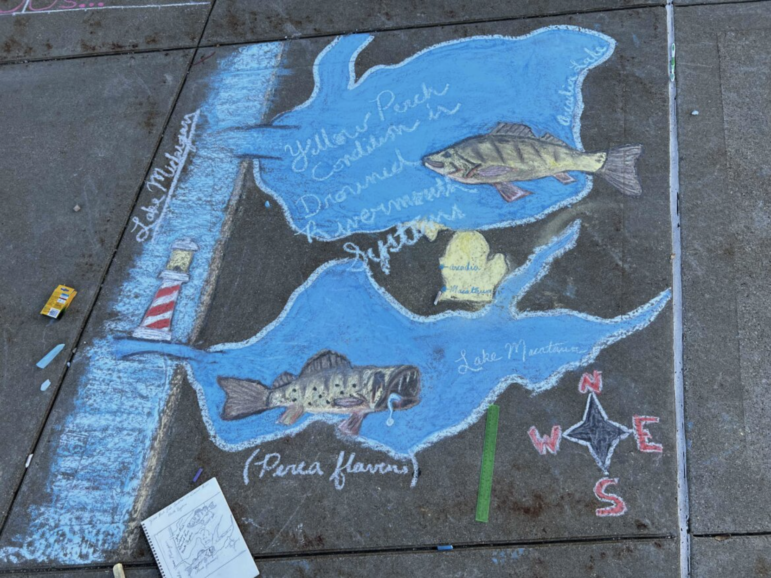
Jacob Yingling
Jacob Yingling’s chalk mural took him two hours to create and many more hours to plan. It reads, “Yellow Perch Condition in Drowned Rivermouth System.”By DANIEL SCHOENHERR
Capital News Service
LANSING – A chalk mural by Grand Valley State University student Jacob Yingling depicts what he studies: yellow perch in drowned river mouth systems.
Through the data Yingling collected for the university’s Annis Water Resources Institute, he discovered that the average weight and health of fish captured at Lake Macatawa is significantly below standard levels.
His artwork was part of a recent Grand Valley Chalk Art Symposium, where dozens of students showcased their work on the Pew Library plaza.
“This was my first time doing something like this,” Yingling said. He said he loves drawing landscapes in his free time and was excited to be a part of the event.
Combining science with artwork allowed people who wouldn’t have otherwise seen his research to see it, said Yingling. “I believe science is really for everyone.”
Attendees approached Yingling throughout the day to find out more about his research.
“A lot of people thought it was cool, and they stopped to ask what it meant and how it was impacting them,” he said.
Great Lakes river mouths are home to ports and cities that have lots of human interaction, according to a 2013 article in the Journal of Great Lakes Research.
The activity can harm marine health through factors such as runoff and improper waste disposal.
Sharing scientific research through artwork is a growing trend, said Michigan State University Museum Creative Director Mark Sullivan.
“Science gives artists opportunities for an approach they have never taken before,” he said. Artistic expression and interpretation can improve the observational skills of scientists, too.
Science and art have come together all over the scientific community, according to another Annis researcher, Michael Hassett.
Institutions nationwide promote seminars through colorful posters, feature artwork in their studies and have even spread water awareness through interpretive dance.
You don’t have to be an activist to take action.
According to Yingling, the people viewing his mural often asked how they could help preserve yellow trout along Michigan’s west coast.
“The best way for us to generate funding is to get the public interested in what we’re doing,” he said.
Just like Yingling, Sullivan’s team gets out into the community with artistic exhibits and performances based on research subjects like climate change, immigration and technology.
“We’re not about sitting on the shelf, but taking action,” Sullivan said.
Daniel Schoenherr reports for Great Lakes Echo.